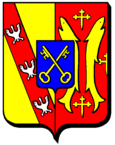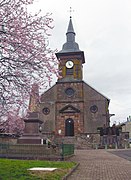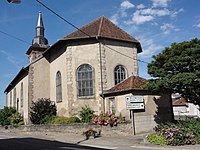Pexonne
| Pexonne | ||
|---|---|---|

|
|
|
| region | Grand Est | |
| Department | Meurthe-et-Moselle | |
| Arrondissement | Luneville | |
| Canton | Baccarat | |
| Community association | Vezouze en Piémont | |
| Coordinates | 48 ° 29 ' N , 6 ° 53' E | |
| height | 273-522 m | |
| surface | 13.43 km 2 | |
| Residents | 365 (January 1, 2017) | |
| Population density | 27 inhabitants / km 2 | |
| Post Code | 54540 | |
| INSEE code | 54423 | |
 Town hall and school building |
||
Pexonne is a French commune with 365 inhabitants (as of January 1, 2017) in the Meurthe-et-Moselle department in the Grand Est region ( Lorraine until 2015 ). The municipality belongs to the Arrondissement of Lunéville and to the municipal association Vezouze en Piémont, founded in 2016 .
geography
Pexonne is located in the western foothills of the Vosges , about two kilometers southeast of Lunéville . In the south-east, Pexonne has a share of the Lac de Pierre-Percée reservoir , which was created for emergency cooling of the Cattenom nuclear power plant 100 kilometers away . Pexonne is surrounded by the neighboring communities of Fenneviller in the north and northeast, Badonviller and Pierre-Percée in the east, Neufmaisons in the southwest, Vacqueville in the west and Sainte-Pôle in the northwest. The holiday home area La Combelle belongs to the municipality .
history
The origin of the village is still unclear. Archival records mentioning the village in 1076 are controversial; the existence of Pexonne is documented for the 13th century. Pexonne was under the Salm family until 1603 and then became part of the Duchy of Lorraine . Pexonne was badly damaged during the wars of the 17th century, partially destroyed in 1651. When King Louis XIV levied high taxes on silver cutlery and crockery in 1672 to finance his wars, this was the reason for the establishment of an earthenware industry. The Pexonne ceramics factories are probably among the oldest in France. On June 30, 1719, Duke Leopold granted a patent for the establishment of a ceramic factory in Pexonne. Ceramic production reached its peak in 1897, when the number of employees grew to 300. The two world wars caused considerable damage to the factory. In 1953 ceramic bricks were produced again with around 50 employees. In 1979, Huguenot-Fenal took over the factory and closed it a few years later in favor of other locations. In 1944, 80 inhabitants of Pexonne were deported, only 17 of them returned to the village.
Population development
| year | 1962 | 1968 | 1975 | 1982 | 1990 | 1999 | 2005 | 2016 |
| Residents | 733 | 683 | 554 | 474 | 446 | 410 | 389 | 369 |
| Sources: Cassini and INSEE | ||||||||
Attractions
- Saint-Pierre-aux-Liens church, built in 1776
- Calvaire
- Fallen memorial
- Ruins of a flourishing brick, tile and ceramic industry from 1690 onwards
- Remnants of a watermill
- extraordinary rock formations with vaults and overhangs in the Val de Vohné
- Saint-Pierre-aux-Liens church
Economy and Infrastructure
In the municipality of Pexonne there are two farms (cattle breeding, dairy farming) and three forest holdings.
In Raon-l'Étape , twelve kilometers away, there is a connection to the motorway-like Route nationale 59 from Nancy to Épinal . The train station in Baccarat, twelve kilometers from Pexonne, is on the Lunéville – Saint-Dié railway line .
supporting documents
- ↑ history ccbadonvillois.com (French), accessed on July 11, 2017
- ↑ Pexonne on cassini.ehess.fr
- ↑ Pexonne on insee.fr
- ↑ Farms on annuaire-mairie.fr (French)
- ↑ Forestry operations on annuaire-mairie.fr (French)



